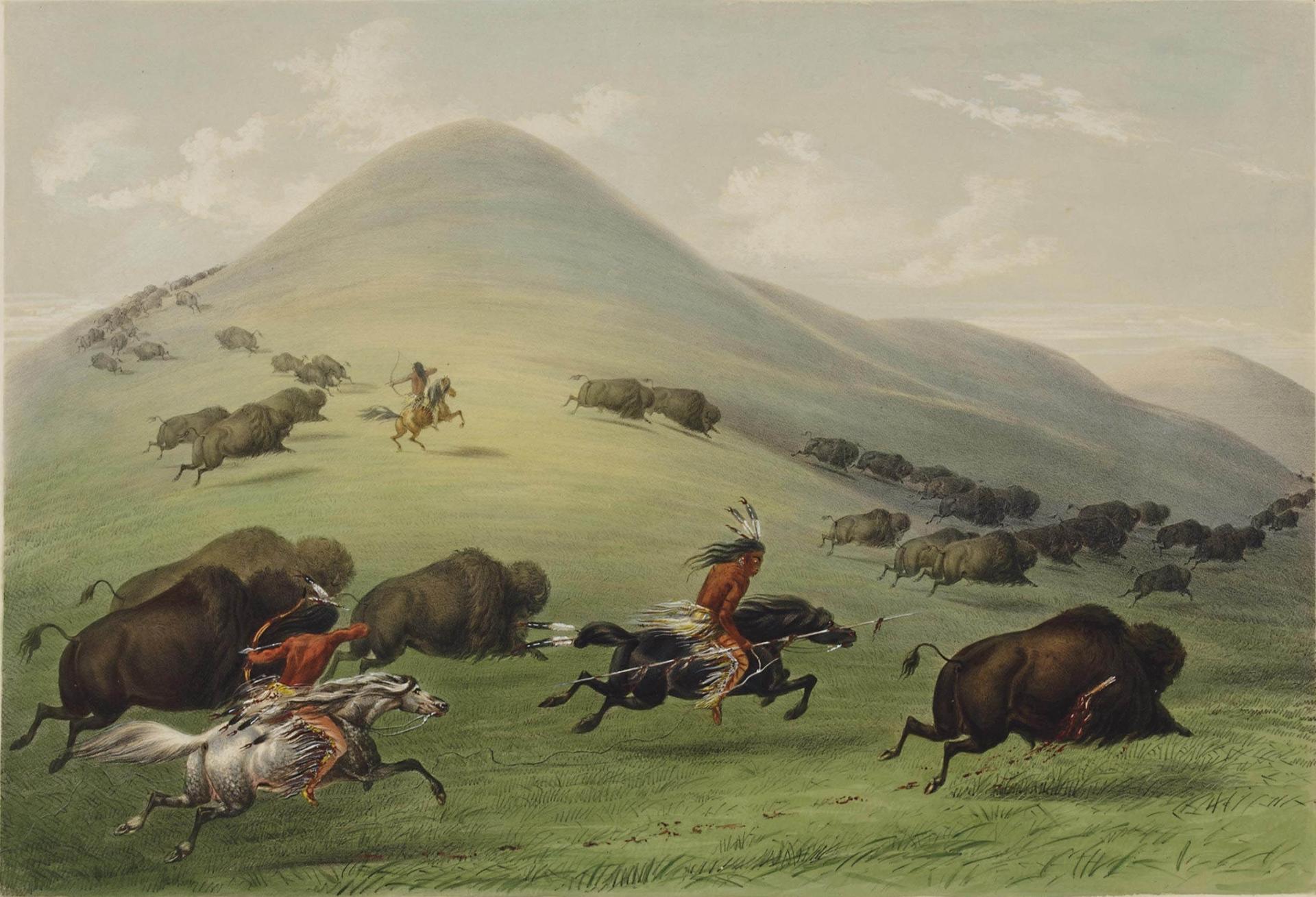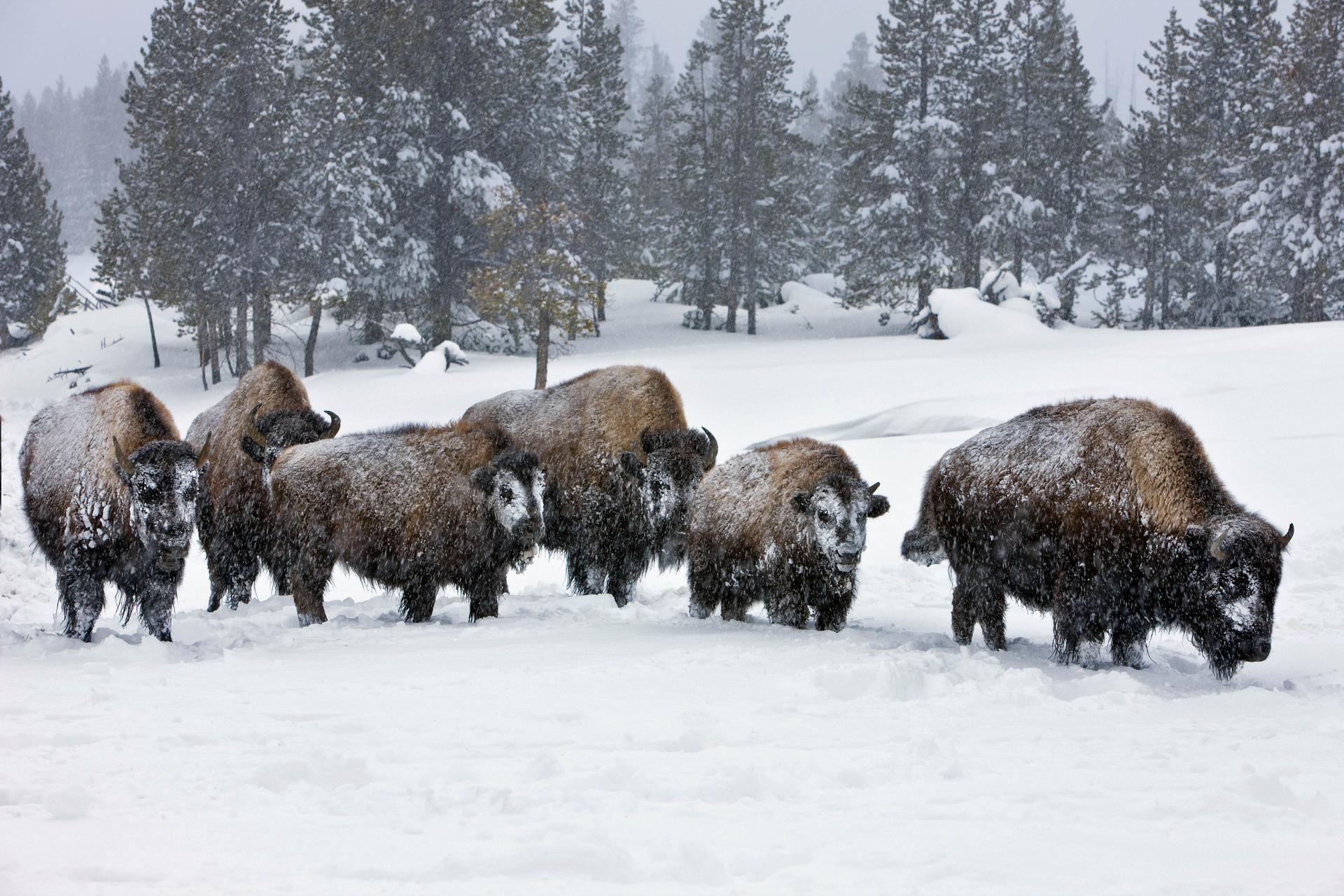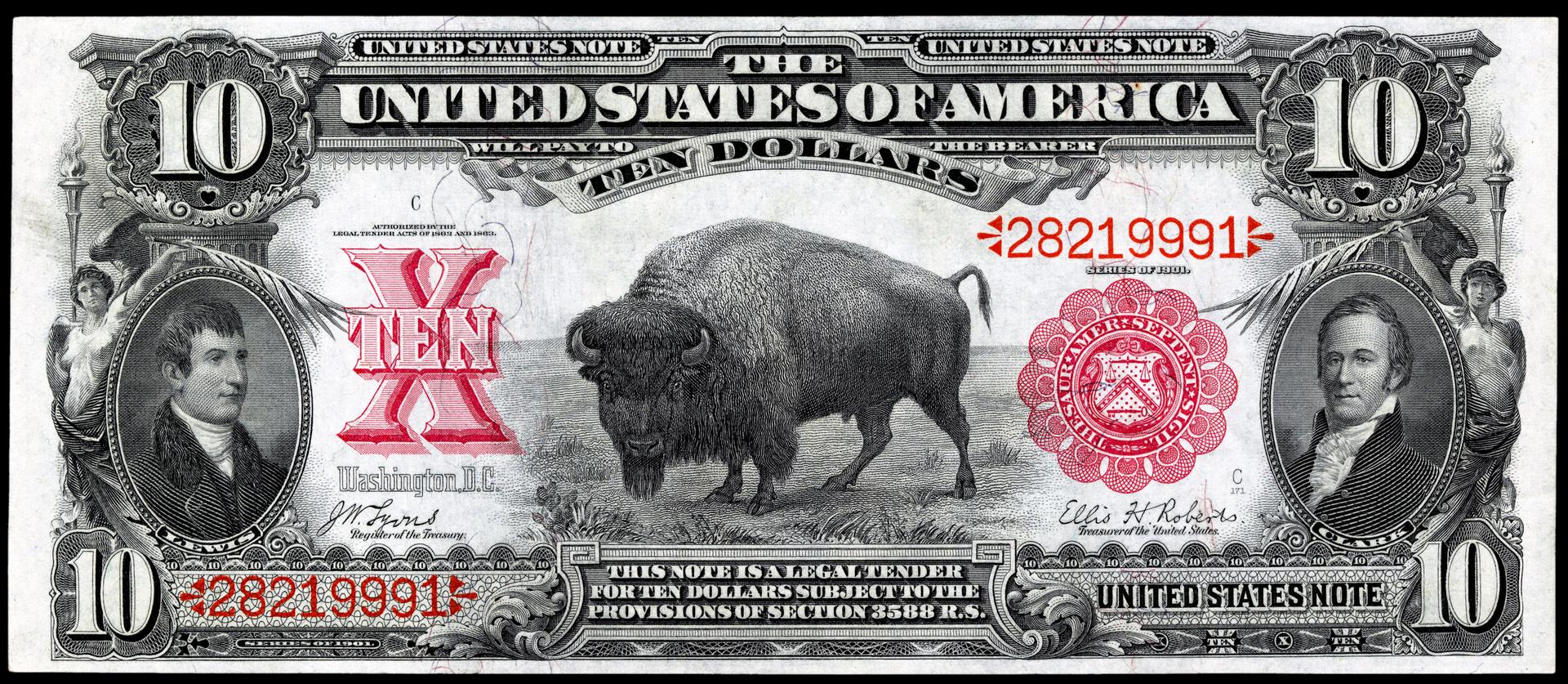Nearly extinct by 1900, the American bison is in the midst of a remarkable comeback in national parks and on Native American reservations. But opposition to letting the buffalo roam on large stretches of public land has been led by ranchers who fear the transmission of a disease called brucellosis to domestic livestock, and dread a restored prairie that has no place for beef cattle.
◊
In mid-October 1871, a young U.S. cavalry lieutenant named George Anderson was on his way to Fort Lyon, in Colorado, when he began seeing bison: “Hundreds,” he recorded later, “where the night before there had been only dozens.” And then, “from the higher points of our route, when the horizon was distant from 10 to 20 miles, hundreds of thousands.”
Slightly over a year later, the young officer noted that the same trail “was lined with buffalo [hunting] camps and I imagine I saw 5,000 skinned carcass [sic] during my trip.” In 1892, Anderson, now a captain, was named the new Army superintendent of Yellowstone Park, which was then managed by the War Department. One of his many responsibilities was protecting the last wild bison herd, maybe 200 animals, sheltering in a remote valley.

George Catlin’s painting of a buffalo hunt he witnessed c. 1838 (Image Credit: Wikimedia Commons)
Between 1868 and 1888, the population of North American bison, popularly called buffalo, went from an estimated 50 million animals that mainly roamed the plains between the Mississippi and Rocky Mountains to, at best, 500 scattered among remote park refuges and private land. With no applicable law against killing Yellowstone’s wildlife, each winter the great beasts were poached with impunity, their very rare and valuable heads and hides sold to taxidermists for wealthy collectors. Though Capt. Anderson was instrumental in getting an 1894 federal law passed protecting Yellowstone wildlife, by 1900 the park’s bison population had dwindled to 25 animals, kept in a corral Anderson ordered built within sight of park headquarters.
The extermination of the bison combined many factors. The repeating rifle and trade in hides – a coat or blanket of buffalo hair offered unparalleled softness and warmth – accelerated the killing. Expansion west of the Mississippi brought a market for bison meat for home consumption, and to feed the thousands of rail workers and soldiers now at work across the plains.
Once Native Americans started a sustained defense of their land in the late 1860s, the Army launched concerted campaigns to wipe out the buffalo as a way to crush indigenous culture and resistance, first on the southern plains and then across the Dakotas. By 1885, the tragic extermination was largely done.
A Slow but Steady Return of the Bison
In 1902, bison from a Native American refuge in Montana and the enormous ranch of a Texas cattle baron were added to the Yellowstone herd. It was from this group of about 50 animals that the current Yellowstone population of approximately 5,000 emerged. Elsewhere, tiny groups on ranches from Texas to Canada inspired a movement to raise bison commercially.
Beautifully adapted to life on the plains, bison require water less frequently than cattle, and are able to forage over greater distances. Unlike cattle, they can defend themselves against the largest western predators, wolves and grizzly bears. (A mature bull weighs nearly a ton, can outrun a horse, and stands over six feet tall at the hump.) Bison mature in three years, and healthy cows can produce a calf annually for up to 20 years. Their herd instinct is so strong that only old or sick animals, unable to keep up with the protecting group, fall prey to attacking carnivores.
When threatened, a bison herd forms a circle with calves at the center and the youngest bulls at the outer ring to face the threat, backed up by their elders of both sexes.
This herd instinct allowed bison to be wiped out by distant hunters with powerful rifles. Without obvious predators in view, groups remained together instead of running when the shooting started.
Bison had begun their climb back from near-extinction. But after 1890, the federal homesteading movement that parceled out their former rangelands as farms faltered and finally collapsed. The 160 acres promised anyone who could work the land proved woefully inadequate to maintain a family. Worse, the prairie soil, when not held together by the long roots of native grasses that had been plowed under for crops, turned to powder in drought years. In a series of gigantic Dustbowl windstorms in the 1930s, it all blew away.
Even as the bison was driven to near extinction, it remained mythically American. Except for the eagle, it is the only animal to appear on standard U.S. currency and was featured on the nickel and $10 bill.
Coinciding with the failed homestead project were attempts to crossbreed ranch bison with cattle. Having originated in the Middle East, cattle can’t survive harsh western winters without help. They require shelter from blistering cold and wind, and can’t forage in deep snow. Unlike cattle, bison metabolisms slow down in winter. Protected by their shaggy coats, they’re impervious to temperatures far below zero. Thus equipped, they use their enormous heads to sweep snow away from the grass they need to survive.

Yellowstone bison in winter (Image Credit: Yellowstone National Park Lodges)
The ranchers’ hope was that crossbreeding the two species would produce an animal as docile as cattle and as hardy and low maintenance as bison. But half of the animals that ensued from early breeding programs were biologically sterile. A hybrid, more cow than bison, eventually emerged. So-called beefalo are expensive to produce, and there’s little consumer demand for their products. This experiment in animal husbandry had the unfortunate outcome of introducing cattle DNA into the bison population, thereby compromising what had been a wild gene pool.
Domestic cattle DNA interferes with the diverse genome that has allowed bison to thrive in the incredibly varied conditions of North America for tens of thousands of years. Modern testing reveals a tiny, inert presence of cattle genes now in most bison outside of Yellowstone Park and other small refuge herds. Though the worst characteristics of cattle genetics have been naturally selected out of commercial bison herds over the past century, the campaign for growing a genetically untainted, wild bison population is an ongoing scientific project.
Recent USDA figures show nearly 200,000 privately-owned bison in the U.S. on more than 1,700 ranches, with another 20,000 on tribal lands. An average of nearly 1,200 commercial bison are slaughtered weekly, their premium-priced meat destined for restaurants and specialty shops.
Managing an Expanding Population
However, the increasing number of wild buffalo presents its own problems. The Yellowstone valleys can be overgrazed, and Park Service policy limits the size of its herd to about 5,000 animals. To keep near that number, animals are culled annually, a practice that has prompted fierce criticism.
Some bison are rounded up in the Park for slaughter, their meat sent to Native American reservations. Others are allowed to leave the park in search of forage on Forest Service land. Once outside the park, they are hunted legally, with licenses granted to Indigenous tribes from across the West.
There’s nothing romantic about this modern buffalo hunt. The animals are downed by semi-automatic rifle fire scant yards from the Yellowstone boundary. Every winter, volunteers, including many Native Americans, attempt to shoo wandering bison away from the edge of the park and certain death. Several conservation groups insist that the great beasts should, like elk, be allowed to roam freely across federal and state land. But bison outside of parks are legally classified as livestock, not game animals, so their movement is strictly regulated.

The 1901 buffalo $10 bill (Image Credit: Wikimedia Commons)
An alternative to culling seemed in sight when, in March 2012, a group of 60 Yellowstone bison were trucked nearly 500 miles to the enormous Fort Peck Indian reservation in northeast Montana. But this program was halted by objections from the state’s stock growers, who insist bison spread disease to cattle.
Like nearly everything about modern bison management, the charge is controversial. The disease in question, brucellosis, can destroy a beef herd’s ability to produce calves. Eradicated in domestic livestock, it exists in Yellowstone buffalo, which it does not appear to harm. Though transmissible in close conditions, there are no recorded cases of brucellosis – which also exists in elk herds – spreading from bison to cattle in the wild.
The mere threat of the disease, though, was enough to halt the transfer from Yellowstone for years. A system of quarantine and testing was instituted, and shipping bison, now certified disease-free, from the park resumed in 2019 with 55 animals sent to Fort Peck. In 2020, the Fort Peck reservation was able to send bison from its herd to sixteen other native tribes.
Reviving the Prairie By Restoring the Bison
National parks and reservation lands are not the only sites dedicated to the bison’s revival in the wild. In 2004, the American Prairie Reserve (APR), a conservation group spun from the World Wildlife Fund, began buying ranches in north central Montana next to federal Bureau of Land Management (BLM) land.
The APR intends to restore bison to about 290,000 acres, the first step toward a 3.5 million-acre park – a jigsaw puzzle of its own land and BLM lease holdings that would connect a large national wildlife refuge along the Missouri River, north to the Fort Belknap and Fort Peck reservations. This plan was met by most nearby ranchers with something approaching rage.
For ranchers, the bison’s reappearance is an existential threat, at once symbolic and real. Cattle prices have been falling for years, while the cost of raising them keeps going up. As more ranches close due to unforgiving economies of scale, wildlife groups like the APR and the Nature Conservancy have been buying land. Their mission is to revive vegetation and wildlife – various ungulates, carnivores, and wildfowl – that had been reduced, driven off, or exterminated over the past 150 years.
The Promise and Problems of the Bison’s Return
The reintroduction of bison to the landscape has enormous potential ecological and economic benefits. Though harder to manage, bison cost a small fraction of what it takes to keep the same number of cattle, and their meat, still a rare commodity, sells at a premium. Their mere presence revives prairie land, its plants and other native species, long stressed by cattle grazing. And bison watching, and hunting, are part of a new eco-tourism economy envisioned for the American West.
But there remain unique problems. You don’t, for example, want to see a buffalo in your headlights on a highway at night. They are powerful and enormous wild animals that can bust through any fence they care to if so inclined. They are also hard to round up, and easy to rile. Though fundamentally shy animals, as we’ve seen on the news, anyone foolish enough to annoy adult bison for too long is in big trouble. It’s better to give them plenty of room and appreciate them from afar.
This may be why bison have captivated the American imagination ever since their near elimination. We admire their endurance and strength, their independence and abiding loyalty to each other. They are inspiring to watch. A running herd moves over and around obstacles with the fluid grace of a river, or wind over long grass. The bison’s return begins to undo a terrible wrong. Even if their numbers remain a fraction of the vast herds that once roamed the plains, they bring back a feeling of possibility and sense of grandeur that the West symbolized before they went away.
Ω
Title Image: Bison herd (Source: Pixabay)

